Hire cart - {{ cart.TotalQuantity }} item{{ (cart.TotalQuantity != 1 ? 's' : '') }}
Cart is empty. Add gear you want to your hire cart and review them here.
There are no branches matching your search.
Login to view or create favourites and other benefits.
Register to start speeding up your hire process and keep track of your hire history.
Nice to see you again. We've made a few changes since you were last here.
Pick a colour
Favourites ({{ userFavourites.length }})
Add your frequently hired items to easily view and hire them again.
Keep your contact information with us up to date so you get the latest and best rates with us.
Hire cart - {{ cart.TotalQuantity }} item{{ (cart.TotalQuantity != 1 ? 's' : '') }}
Cart is empty. Add gear you want to your hire cart and review them here.
When working on big jobs such as clearing or felling trees, it is common for the chain on your chainsaw to become blunt over time. Operating a blunt chainsaw makes the task of cutting down trees more difficult and can be very dangerous. In these instances, it’s better to replace the chain on your chainsaw before pressing on with the task.
On request, Hirepool is happy to provide a replacement chain for your chainsaw when hiring. In this guide, we’ll cover how to safely change the chain on both Husqvarna and Stihl chainsaws. Let’s get started!
Low Stock Call First
High Demand Product: We suggest making a booking for this item in advance.
Low Stock Call First
High Demand Product: We suggest making a booking for this item in advance.
Low Stock Call First
High Demand Product: We suggest making a booking for this item in advance.
Low Stock Call First
High Demand Product: We suggest making a booking for this item in advance.
Low Stock Call First
High Demand Product: We suggest making a booking for this item in advance.
At Hirepool, we stock a wide range of chainsaws depending on the size of your job.
This petrol chainsaw is the perfect size for cutting firewood. Its specifications are as follows:
|
Make |
Various |
|
Model |
Various |
|
Bar length |
609-635mm |
|
Fuel tank capacity |
0.7lit |
|
Run time |
30mins |
|
Noise level |
105-107dB |
|
Length |
960-1112mm |
|
Width |
350mm |
|
Height |
350mm |
|
Weight |
7.3-8.3kg |
This particular petrol chainsaw is slightly smaller than the 24” to 30” but is still a fantastic option for cutting firewood. Here are its specs:
|
Make |
Various |
|
Model |
Various |
|
Bar length |
508mm |
|
Fuel tank capacity |
0.6-0.65lit |
|
Run time |
35min |
|
Noise level |
104-106dB |
|
Length |
850mm |
|
Width |
150mm |
|
Height |
350mm |
|
Weight |
6.8-7.2kg |
This smaller petrol chainsaw is great for trimming trees or cutting smaller firewood. Its specifications are as follows.
|
Make |
Various |
|
Model |
Various |
|
Bar length |
06-457mm |
|
Fuel tank capacity |
0.4lit |
|
Run time |
30min |
|
Noise level |
102-103dB |
|
Length |
700-750mm |
|
Width |
300mm |
|
Height |
300mm |
|
Weight |
5.4-6.1kg |
This battery powered chain saw is great for hedge trimming and cutting light firewood. It’s a lot quieter than petrol chainsaws, making it perfect for residential areas. Here are its specs:
|
Make |
Stihl |
|
Model |
MSA200-MSA220 |
|
Bar length |
350mm to 400mm |
|
Fuel tank capacity |
N/A |
|
Run time |
40min per battery |
|
Noise level |
84dB |
|
Length |
650mm |
|
Width |
300mm |
|
Height |
300mm |
|
Weight |
4.2kg |
This wee pruning saw packs a punch, making it ideal for cutting up garden waste, shrubs and pruning trees. Here are its specs:
|
Make |
Stihl |
|
Model |
GTA 26 |
|
Bar length (cm) |
10 or 4” |
|
Rated voltage (V) |
11 |
|
Weight (kg) |
1.2 |
|
Chain gauge |
¼”P |
|
Chain par#: |
3670 000 0028 |
If you have any questions about which chainsaw option to choose, feel free to reach out to the friendly team at your local Hirepool branch.
Safety is of utmost importance when handling your chainsaw. A blunt chainsaw can do as much harm as a sharp one, so remain alert and cautious when handling your saw.
Wear thick protective gloves when handling your chainsaw chain, even if the chain is blunt.
Ensure you are wearing protective footwear, preferably steel-capped with good ankle support.
If you are operating a chainsaw, protective chaps are recommended and available to hire from Hirepool.
We also recommended wearing safety glasses when changing your chainsaw chain. Ear protection is not needed when the saw is switched off, but necessary for operation.
For more safety information, check out Worksafe’s guide on safety with chainsaws.
Wondering how to tell if your chainsaw chain is sharp or blunt? There are a few signs to look for:
You will know you need to replace the chain when you notice any of these issues with your saw. If it’s is no longer efficiently cutting through wood, or the tooth on the chain appears rounded, it’s time to change your chain.
Before you replace your chain, ensuring the motor is switched off and the saw has had time to cool down.
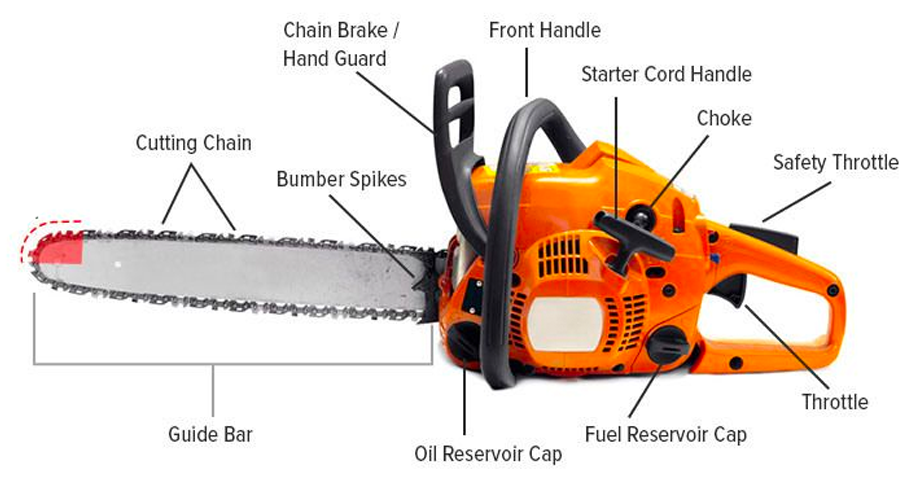
First, disengage the chain brake by pulling the chain brake guard backwards towards the front/top handle.
A chainsaw's brake is sometimes attached to the guide bar side plate - which is most commonly seen on a Husqvarna chainsaw. It’s important to disengage the brake before you attempt to remove the side plate. Failure to do so will result in a difficult time when you need to put the cover back on the machine.
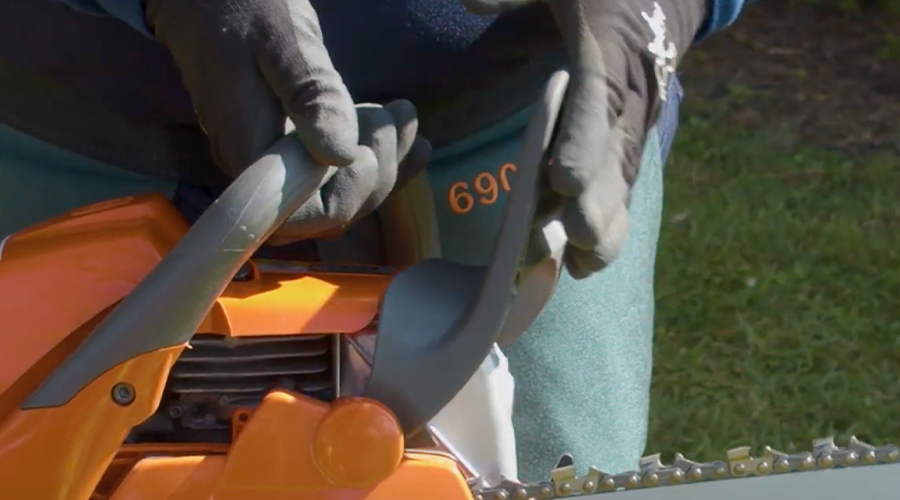
To do this, unscrew the nuts holding the cover to the engine with a socket wrench. You can also use the combination wrench that Hirepool supplies with the saw. Once nuts are unscrewed, remove the cover to access the chain.
Some chainsaw models are equipped with ‘toolless tensioning’. This makes accessing the chain a breeze. To access the chain, simply lift the handle & turn counter-clockwise to loosen & remove the clutch cover.
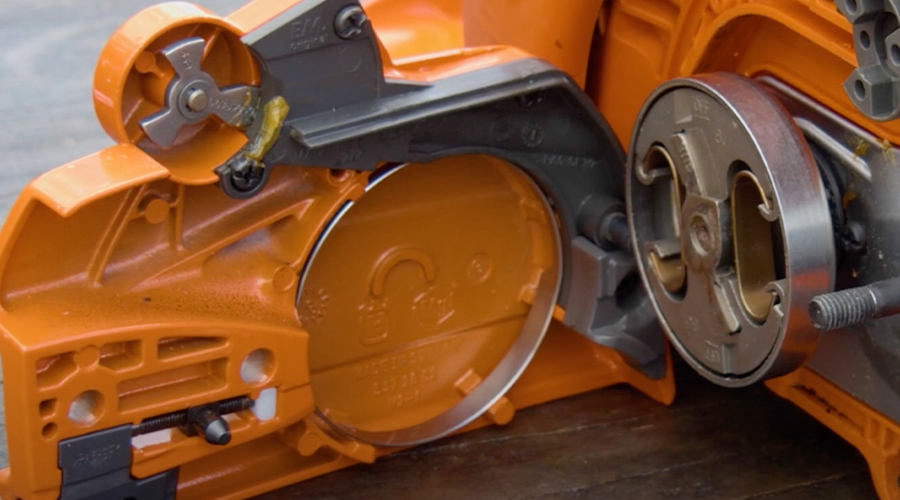
Loosen the chain tensioning screw on the engine body.
Typically, this is located on the opposite side of the bar from the cover or can sit between the two bar nut placements. To loosen, turn it counterclockwise as far as it will go. When there is enough slack in the chain, lift the chain off the sprocket and bar.
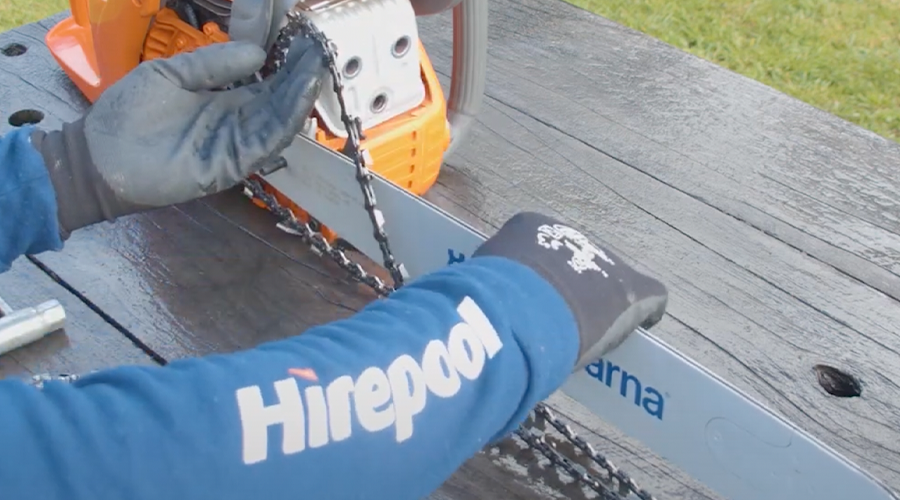
If using a Hirepool airless sprayer for the first time, ask the team at Hirepool how to use the sprayer before you head home. The machine should be clean and ready to go.
Place the Spray unit into the paint or into the pot for hand held sprayers. Test and or practise on some old board or cardboard before starting your project to get used to the flow of paint. If using it over a number of days, make sure it’s been cleaned well before each use to avoid clogging.
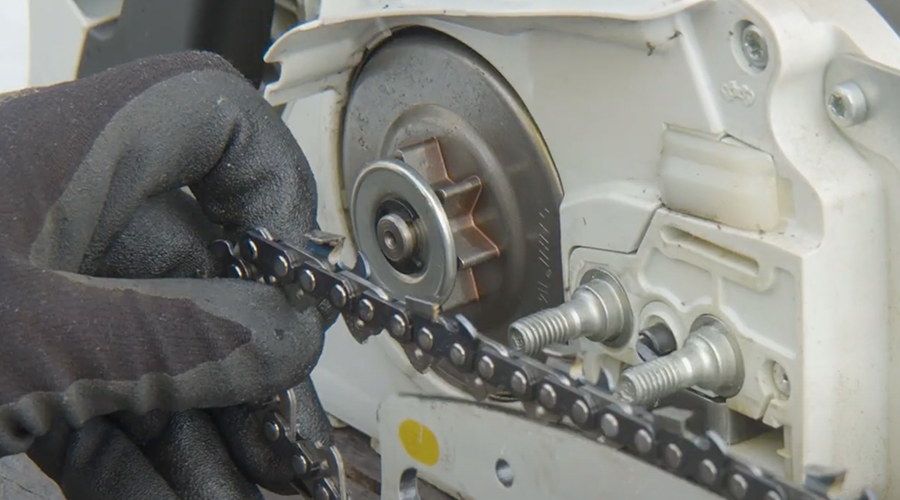
To do this, turn the chain adjuster peg clockwise to slightly tighten the chain. Sometimes you may need to back off the chain adjuster peg a little, so the chain, bar and sprocket all fit into place. Once the chain is in place you can take the side cover and place it back on the body. Tighten up the bar nuts so they’re about a half a turn loose or finger tight.
Once your chain, bar and sprocket are fitted together and back inside the chainsaw body, you need to tighten the chain. The chain is correctly tensioned when it does not sag from the underside of the bar, but can still be turned easily by hand.
To tension, the chain, hold up the bar tip slightly so most of the cutting is on the underside of your bar. Then take the bar spanner and place it into the adjuster peg. Tighten the chain until the slack is taken up and it appears to be sitting snug against the bar while the bar tip is raised.
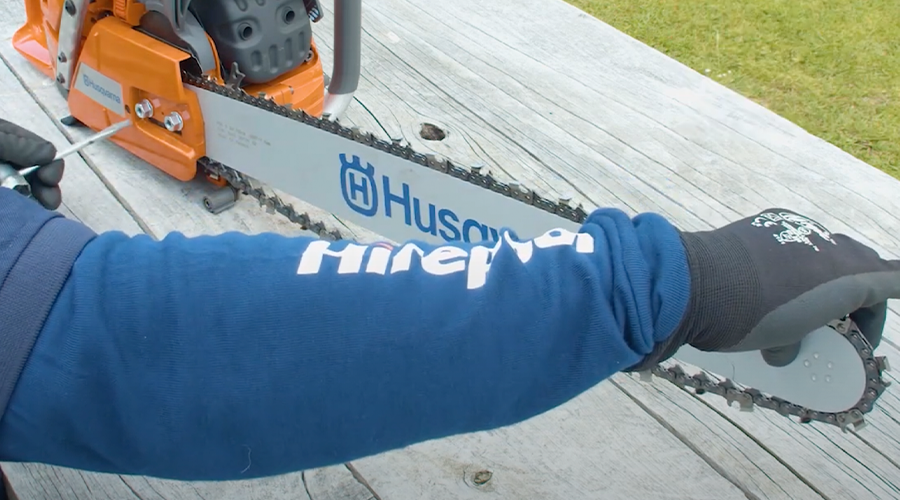
Turn the chain over, using your combi spanner to ensure the chain is not so tight that it can’t turn freely. Then simply tighten the bar nuts and you’re good to go!
As you cut with your chainsaw, your bar will naturally work its way up. Regardless of how tight the bar nuts are tightened, your chain will still lose tension and need to be checked frequently. Take time to tighten as you cut until the chain is run in.
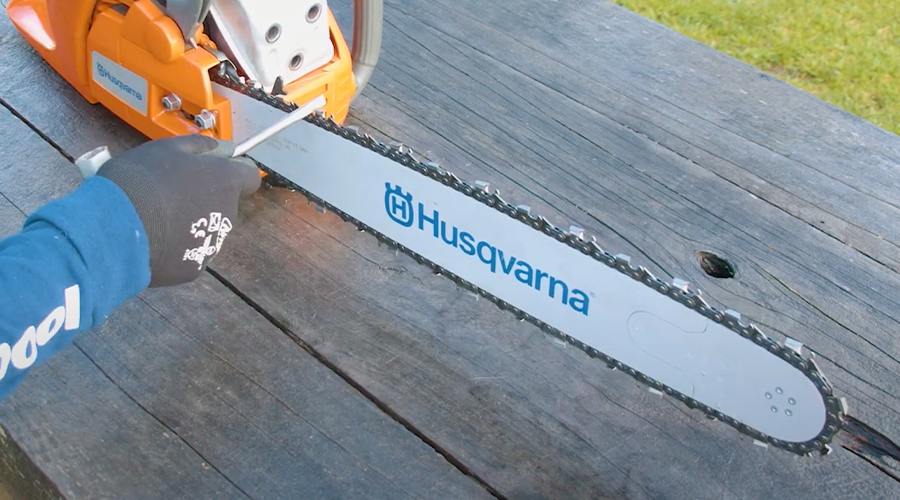
And there you have it, a chainsaw with a fresh chain, ready to handle whatever job you want to do next. Still have a few chainsaw questions? Check out our full guide on everything you need to know about chainsaws before you begin. At Hirepool, we make chainsaw hire fast and convenient.
We only stock professional-grade Husqvarna and Stihl chainsaws, so you get a clean cut every time. Hire chainsaws and pruning saws from Hirepool online now, and then pick up from your nearest Hirepool branch. Be sure to allow a little bit of time for when you pick you your chain saw so your friendly Hirepool team can give you a quick run down on the equipment. .